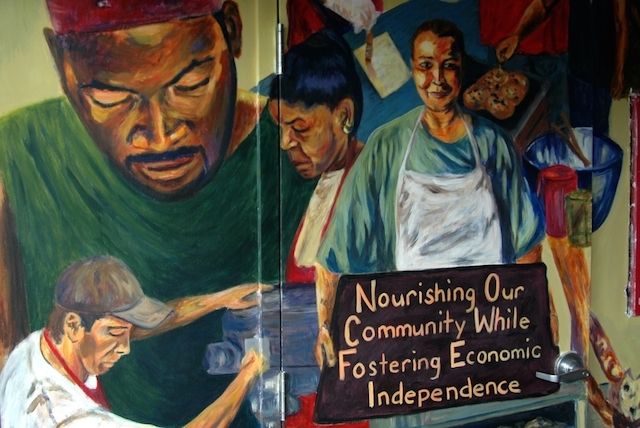
A mural outside Roxbury’s Haley House Bakery Cafe, whose mission is to “help those made vulnerable by the harshest effects of inequality move toward wholeness and economic independence.”
More than 32 million Americans live and work in distressed urban communities, yet their voices often remain unheard. Inner cities— neighborhoods with concentrated and high rates of poverty and unemployment— are ground zero for the battle against poverty; however, they are regularly overlooked for investment.
For twenty-three years, ICIC, one of the principal non-profits for inner-city revitalization, has been leading the charge to bring more attention, capital and expertise to America’s urban neighborhoods. In doing so, ICIC is creating a voice for urban opportunity.
To better understand the current state of inner cities across the country, I recently caught up with Kim Zeuli, Senior Vice President and Director of Research for ICIC. Zeuli’s research includes projects on high growth clusters, industrial strategies, anchor institutions and small business ecosystems — all critical for ensuring opportunity is created in distressed communities.
What's the state of America's inner cities?
While there has certainly been an influx of new residents into cities that has revitalized neighborhoods, it isn’t as pervasive as people think. Inner cities represent 10% of U.S. population, 16% of unemployment, 22% of poverty, and 32% of minority poverty. The biggest challenge in inner cities today is solving the unemployment problem. There is a significant population disconnected from the jobs being created—they lack foundational skills, appropriate networks to find jobs, and may be hard to employ because of prior incarceration or drug use. But there are bright spots in inner cities—a lot of attention is being focused on solving the unemployment issue with innovative programs and policies being enacted across the country. We also see a lot of business growth in the inner cities and they continue to offer competitive advantages for some industries.

Much has been written about the "suburbanization of poverty." Is poverty shifting from inner cities to the suburbs?
I would characterize it more as an expansion of poverty beyond core urban neighborhoods. As I said earlier, there is still a lot of deep poverty in our nation’s cities, and I believe the narrative of the “suburbanization of poverty” sends the wrong message—that policies and programs should also shift their focus to different areas. We need better, more rigorous studies that track the spatial dimensions of poverty to inform our policies and programs.
We hear a lot about gentrification in our cities. Is this having an impact on inner cities? How do we improve our cities but help keep residents in their communities?
Displacement is the perennial challenge of development in any area and there are no easy answers. The rapid gentrification that is happening in some urban neighborhoods—such as in New York, D.C., and Boston—is perhaps creating even greater displacement as residents are not able to adapt to rapidly rising rents. Some interventions, such as affordable housing policies and better workforce solutions, can help in the short-term, but the real solution is making sure there are no “inner cities”—no neighborhoods that are left behind and disconnected from the economic growth of the surrounding city. When that happens, it creates situations that are ripe for rapid gentrification.
What role does entrepreneurship play in creating opportunity in distressed communities? Should we focus on supporting startups or local businesses?
Entrepreneurs create jobs, wealth, and innovation that can help support the growth of other businesses. They are vital to local economies. At the same time, our recent research shows that supporting the growth of small, local businesses, especially those located in inner cities, could have a major impact on decreasing unemployment in these areas.
Is there a city that has made a sustained commitment to support inner city entrepreneurship? What's been the impact?
Most public programs that support entrepreneurs are not place-based—unless they are in a newly designated tech corridor or arts district. They are generally focused on all entrepreneurs or those within a certain industry or demographic (minorities or women, for example). There are a growing number of entrepreneurial support organizations (incubators, accelerators, co-working spaces) being established in inner cities, but it is too early to measure their impact. The goal behind these organizations is to spur more entrepreneurship in these areas in a wide variety of industries, including those that would make jobs accessible to many inner city residents, so they could have a significant impact.
A significant number of anchor institutions—universities, hospitals, corporate headquarters, and cultural institutions—are located in inner cities. What can they do to help grow our urban communities?
Anchor organizations are critical to inner cities. They are major employers, purchasers, real estate owners, developers, and provide healthcare and education. Some anchor organizations are also doing much more: making greater investments in their inner cities, hiring more local residents, strengthening workforce programs, purchasing more from local businesses, building the capacity of local businesses, and supporting the development of more affordable housing and better transportation options.
In Cleveland, anchor institutions have leveraged their collective strength through the Greater University Circle Initiative and are transforming inner city neighborhoods. Detroit, Baltimore, Chicago, and New Orleans are other examples of cities where anchor organizations are playing significant roles in creating more economic opportunities in their inner cities. We are also supporting an exciting new anchor collaboration effort in Newark, which has the potential to transform the future of the city.
The Trump Administration has a presented a budget that makes drastic cuts to federal economic development efforts. How will this impact our inner cities?
The proposed budget cuts could potentially stop any progress that has been made in our inner cities and exacerbate economic and social problems. Eliminating HUD’s $3 billion Community Development Block Grant (CDBG) program would likely mean a reduction in workforce programs and funding for inner city revitalization efforts and business loans. Funding for Community Development Financial Institutions (CDFIs), which provide financial services in economically distressed neighborhoods, are also part of the proposed cuts. These private financial institutions are mandated to direct funds to people and businesses in low-income communities that struggle to access traditional sources of capital.
